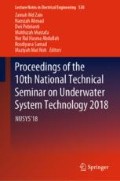Abstract
Underwater communication has a great importance in either industrial, military or for scientific purposes. The applications of underwater communication such as pollution monitoring, underwater surveillance and collection of scientific data from the bottom of the ocean require specific development of devices. In order to design these crucial devices for such activities, an accurate characteristic of water involved should be noted. The velocity of signal propagates in underwater is different from the speed of light in free space and closely related to complex permittivity. There are few types of water bodies such as rivers, streams, pond, bays, gulfs and seas where each of them possessed different characteristics. In this paper, the main focus is to determine the water bodies’ characteristics by using material characterization method. This paper provides the characterization of the different water bodies such as tap water, river water, sea water and lake water where the complex permittivity are determined by using resonant method. Estimated complex permittivity of different water are in good agreement with existing method; the error is below than 6%. The present method shows a great potential to be used in characterizing wide-variety of liquid samples.
Access this chapter
Tax calculation will be finalised at checkout
Purchases are for personal use only
References
Kaushal, H., Kaddoum, G.: Underwater optical wireless communication. IEEE Access 4, 1518–1547 (2016)
Zhang, X., et al.: Underwater wireless communications and networks: theory and application: Part 1 [Guest Editorial]. IEEE Commun. Mag. 53(11), 40–41 (2015)
Kim, S., et al.: A free-space measurement method for the low-loss dielectric characterization without prior need for sample thickness data. IEEE Trans. Antennas Propag. 64(9), 3869–3879 (2016)
Karim, M.S.B.A., Konishi, Y., Kitazawa, T.: Robustness analysis of simultaneous determination method of complex permittivity and permeability. In: 2014 international conference on numerical electromagnetic modeling and optimization for RF, microwave, and terahertz applications (NEMO), pp. 1–4, Pavia (2014)
Karim, M.S.B.A., et al.: Determination of complex permittivities of layered materials using waveguide measurements. IEEE Trans. Microw. Theory Tech. 62(9), 2140–2148 (2014)
Kobata, T., et al.: Determination of complex permittivity of materials in rectangular waveguides using a hybrid electromagnetic method. In: Computational electromagnetics workshop (CEM), pp. 56–57, Izmir (2013)
Karim, M.S.B.A., Kitazawa, T.: Determination of material parameters based on hybrid numerical methods using complementary source quantities. IEICE Trans. Electron J98-C, 356–365 (2015)
Baker-Jarvis, J., et al.: Dielectric characterization of low-loss materials a comparison of techniques. IEEE Trans. Dielectr. Electr. Insul. 5(4), 571–577 (1998)
Baker-Jarvis, J. et al.: Dielectric and conductor-loss characterization and measurements on electronic packaging materials. In: Technical note (NIST TN), No. 1520 (2001)
Karim, M.S.B.A., Binti Abu Talip Yusof, N., Kitazawa, T.: Scattering analysis of rectangular cavity with input and output waveguides and its application to material characterization. In: IEEE Asia Pacific Microwave Conference, Kuala Lumpur, pp. 588–591 (2017)
Kinoshita, M., et al.: A method of evaluating high-permittivity and lossy materials using a cylindrical cavity based on hybrid electromagnetic theory. Jpn. J. Appl. Phys. vol. 9, pp. 09LF03–09LF03-5 (2012)
Krupka, J.: Properties of shielded cylindrical quasi-TE0mn-mode dielectric resonators. Trans. Microw. Theor. Tech. 36(4), 774–779 (1988)
Ellison, W.J.: Permittivity of tap water, at standard atmospheric pressure, over the frequency range 0–25 T Hz and the temperature range 0–100 °C. J. Phys. Chem. Ref. Data 36(1) (2007)
Somaraju, R., Trumpf, J.: Frequency, temperature and salinity variation of the permittivity of seawater. IEEE Trans. Antennas Propag. 54(11), 3441–3448 (2006)
Acknowledgements
The work was partly supported by the Research and Innovation Department, Universiti Malaysia Pahang (grant number RDU170370).
Author information
Authors and Affiliations
Corresponding author
Editor information
Editors and Affiliations
Rights and permissions
Copyright information
© 2019 Springer Nature Singapore Pte Ltd.
About this paper
Cite this paper
Awang Akbar, S. et al. (2019). An Accurate Characterization of Different Water Properties Using Resonant Method for Underwater Communication Activity. In: Md Zain, Z., et al. Proceedings of the 10th National Technical Seminar on Underwater System Technology 2018 . Lecture Notes in Electrical Engineering, vol 538. Springer, Singapore. https://doi.org/10.1007/978-981-13-3708-6_10
Download citation
DOI: https://doi.org/10.1007/978-981-13-3708-6_10
Published:
Publisher Name: Springer, Singapore
Print ISBN: 978-981-13-3707-9
Online ISBN: 978-981-13-3708-6
eBook Packages: EngineeringEngineering (R0)

